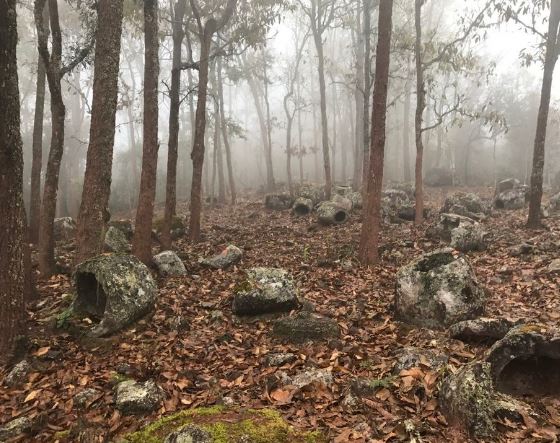A MYSTERIOUS collection of giant ancient jars where people dumped corpses a thousand years ago in Southeast Asia is still raising eyebrows nearly 100 years after it was discovered.
The spooky pots – dubbed the “Jars of the Dead” – are dotted around forests and baking plains in Laos are believed to have been used by remote tribes during ritualistic burials.
PJARPEerie pots known as the ‘Jars of the Dead’ are believed to be used by local tribes in Laos for ritualistic burials[/caption]
PJARPA collection of more than 130 jars used to store the remains of the dead were discovered in 2019[/caption]
Thousands of the creepy urns have been found spread across the secluded mountains in the north of the country since French colonisers stumbled upon them in the 1930s.
Made of dense sandstone or granite, some reach a staggering three metres tall.
The majority date back to the Iron Age, between 500 BC and 500 AD.
Scientists still aren’t sure who built them, or precisely what they were used for, though skeletons at some of the sites suggest a link to burial rituals.
Experts believe the sites were ancient burial grounds used to dispose of ashes or corpses.
It comes after a separate team of Australian scientists in 2019 discovered 137 of the creepy jars at 15 sites across Laos, shedding fresh light on their elusive origins.
They are believed to be about 1,000 years old and were somehow dragged miles to their eventual resting places from far-flung quarries.
Urns are mostly arranged in clusters ranging in number from one to several hundred.
Soon to become a World Heritage site, scientists plan to continue excavations to uncover all they can about the ancient people of Laos.
And while they’re convinced the jars are giant ancient urns, locals have a different idea.
Legend has it the jars were placed there by giants more than a thousand years ago.
The mystical folk supposedly used them for victorious winemaking after a huge battle – though we certainly wouldn’t recommend drinking from one.
Elsewhere, researchers uncovered a medieval graveyard of “vampire children” buried with protections to stop them rising from the dead.
The Jars of the Dead
Here’s everything you need to know…
The Jars of the Dead is a collection of thousands of mysterious ancient jars discovered in the 1930s
Over the past century, nearly one hundred sites have been found deep in the mountains of northern Laos, in Southeast Asia
Each jar, some as high as three metres, weighs several tonnes
The sandstone, granite and limestone used to make them was potentially dragged hundreds of miles
Scientists aren’t sure what the jars, which date to between 500 BC and 500 AD, were built for
The leading theory is that ancient tribes used to dump bodies in them as part of a traditional funeral
A local legend says the jars were built by giants for victorious winemaking after a huge battle in the region 1,500 years ago
One of the biggest collection of urns, the Plain of Jars, is soon to become a world heritage site
The site was dug up in Koszalin, northwest Poland, with two child skeletons uncovered in the earth.
Archaeologists found the so-called “revenant” graves with the children buried in special pits without coffins.
Local folklore from the time shows the term referred to people who would come back from the dead to torture the living.
People would give them horrific burials, taking extreme measures to protect themselves.
The discovery in Góra Chełmska, a ridge near the city of Koszalin, dates back to the 13th century.
One of the scientists said the site bore signs of an “anti-vampire” burial, in a type of grave found all across Europe.
They were designed to stop the dead from rising – such as by placing large stones on the legs of the person being buried.
The body might also have been pierced with a lance to fix it permanently to the ground.
PJARPThe jars are spread across hundreds of sites in a remote plain in the southeast Asian country[/caption]
PJARPThe jars are mostly arranged in clusters ranging in number from one to several hundred[/caption]
Leave a comment








